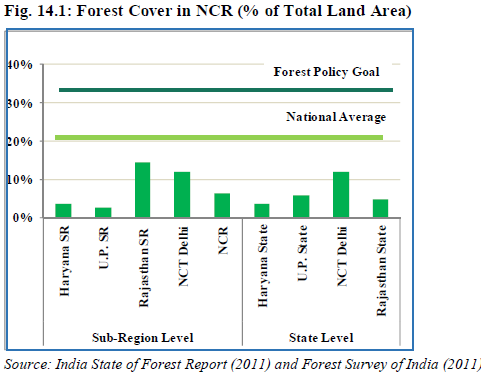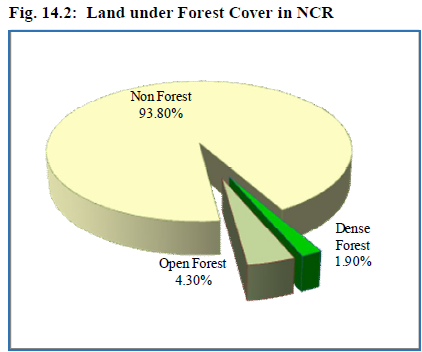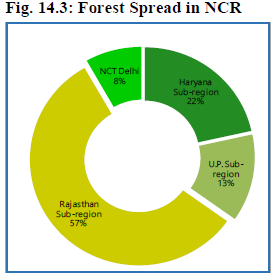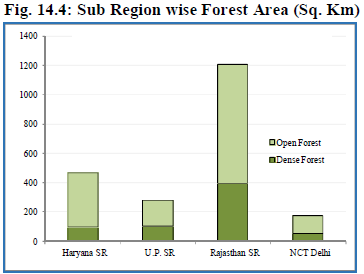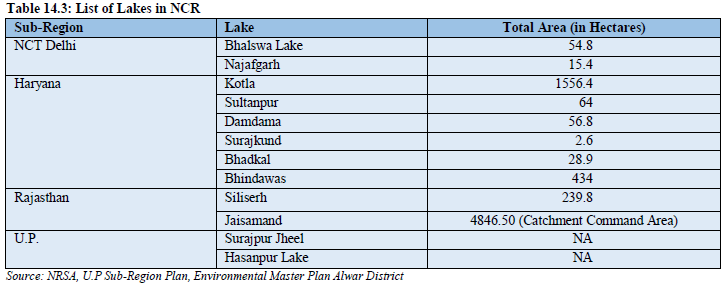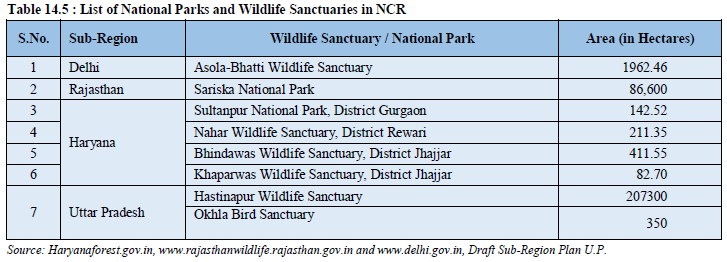National Capital Region (India): Environment
| Line 238: | Line 238: | ||
from south and sprawls towards Delhi. The Ridge has been divided into four zones (Table 14.4). | from south and sprawls towards Delhi. The Ridge has been divided into four zones (Table 14.4). | ||
| − | + | ||
ii. Aravalis at Gurgaon and Faridabad, Haryana – The major portion of forest areas in Aravali | ii. Aravalis at Gurgaon and Faridabad, Haryana – The major portion of forest areas in Aravali | ||
| Line 246: | Line 246: | ||
Tijara subdivision and runs southward. The hilly ranges enclose between the fertile valleys and | Tijara subdivision and runs southward. The hilly ranges enclose between the fertile valleys and | ||
alluvial plains. | alluvial plains. | ||
| + | |||
A) Acts, Notifications and Court Directives on Aravali | A) Acts, Notifications and Court Directives on Aravali | ||
Aravali Notification, 1992 - The Ministry of Environment & Forests vide Aravali notification dated 7th | Aravali Notification, 1992 - The Ministry of Environment & Forests vide Aravali notification dated 7th | ||
Revision as of 16:07, 16 January 2014
This article has been sourced from an authoritative, official readers who wish to update or add further details can do so on a ‘Part II’ of this article. |
The source of this article
Draft Revised Regional Plan 2021: National Capital Region
July, 2013
National Capital Region Planning Board, Ministry of Urban Development, Govt. of India, Core-4B, First Floor, India Habitat Centre, Lodhi Road, New Delhi-110003
National Capital Region Planning Board
National Capital Region (India): Environment
BACKGROUND
NCR is a predominantly an urban region with more than 108 urban centers and 62.5% urbanization as against the all India average of 31.2%. The region is endowed with several ecologically sensitive natural features which needs to be preserved and protected. However, the pressure to convert agricultural land into non-agricultural and abiotic uses in order to realize the high land value potential is extremely severe. The Regional Plan 2021 for the National Capital Region calls for a balanced approach, incorporating environmental considerations into planning process for a sustainable development of NCR. This chapter on Environment focuses on: i. Forests ii. Air iii. Water (surface) iv. Notable environmentally sensitive areas within the NCR. It discusses the present status, temporal changes, issues of major concern, and finally the way forward.
14.2. FORESTS IN THE NATIONAL CAPITAL REGION
Forests are an important natural resource and once degraded the land is usually unable to support forests again. The ever increasing demand for food, fuel, fodder and the growing demand of land for urbanization has however, put tremendous pressure on the scarce forest resources of the region. The National Forest Policy, 1988, aims to have a minimum of 1/3rd of the total land area of the country under forest and tree cover. The following sections discuss the current status of forest cover and temporal change over the last decade (based on India State of Forest Reports, 2001, 2005, 2009 and 2011, FSI) in the NCR. It may be noted that the definition of green areas presented in the Regional Land Use Chapter differ from the definition of forest cover in this Chapter due to: (i) the green areas in Regional Land use Chapter include dense forest areas, forest vegetation and scrubs (ii) same definition was used in 1999 for the land use change analysis. In this Chapter, FSI Data has been used to analyze forest cover in NCR and comparison with all India figures.
14.2.1 Present Status of Forest Cover in NCR. At all India level, forest cover forms 21% of the total Geographical Area. In the National Capital Region, forests are spread over an area of 2131.2 sq. km., which is 6.2% of the total land area of NCR (India State of Forest Report, 2011). Within NCR, Rajasthan sub-region has 14.4% of its total land area under forest cover, followed by Sub-Regions of NCT Delhi (11.9%), Haryana (3.5%) and Uttar Pradesh (2.6%) respectively (Annexure 14/I). Besides forest cover, at all India level, 2.76% of the total geographical area is under tree cover, thus improving the percentage area under total forest and tree cover to 23.81%. In NCT Delhi, tree cover forms 8% of total geographical area, and with forest cover of 11.9%, the total area under forest and tree cover forms 19.9% (Figures 14.1 and 14.2).
Box 14.1
Proportion of forest cover in NCR to its total geographical area is 6.2% against a national average of 21.05% None of the sub-regions of the NCR have forest cover comparable with the present All- India average.
Note: Dense forests include very dense to moderately dense forests. The Forest Survey of India conducts the assessment of forest resources biannually and classifies forests as: (i) Very Dense Forest (> 70% canopy density); (ii) Moderately Dense Forest (40%-70%), (iii) Open Forest (10-40%) and (iv) Scrub (< 10%).
Dense forests are more productive than the Open forests which have much lesser canopy density (Table 14.1). As forest degrades, the canopy density also decreases. In terms of spatial concentration, of the total area of 2131.2 sq. km., nearly 57% of the forest cover in NCR is in Rajasthan Sub-region (mainly concentrated in Aravali mountain range), followed by 22% in Haryana sub-region. UP sub-region accounts for 13% of NCR forest cover, and the rest 8% is in NCT Delhi (Figure 14.3 and Figure 14.4).
A) Region Wise Current Status (2011)
(i) NCT Delhi - The forests in NCT Delhi are spread over 176 sq. km. (11.9% of area), while the recorded forest area is 85 sq. km. (5.7% of area), comprising reserve and protected forests (Figure 14.5). Besides, NCT Delhi has considerable tree cover (120 sq. km. or 8.0% of area), and thus the total area under forests and tree cover is (296 sq. km. or 19.9% of area). Of the total forests, 32% are dense forests; rests are open forests.
(ii) Haryana - In Haryana sub-region, forests are mostly situated in Gurgaon and Faridabad districts. The forest cover in Haryana sub-region in 2011 is 468 sq. km. (3.5% of area) (Figure 14.5). Of the total forests in the sub-region, 21% are dense forests, and the rest are open forests. Four districts – Panipat, Sonepat, Rohtak and Jhajjar have less than 2% of the total geographical area under forest cover.
(iii) Uttar Pradesh - Uttar Pradesh sub-region has least forest cover, as compared to other sub-regions of NCR, (Figure 14.5). It has a forest cover of 282 sq. km., which is about 2.6% of the total geographical area of the sub-region (36% are dense, and the rest 64% are open forests).
(iv) Rajasthan - Rajasthan sub-region has a forest cover of 1,205 sq. km., which is about 14.4% of its total geographical area. This sub-region has the largest forest cover in the NCR – about 56.5% of total forest cover of NCR is in Rajasthan sub-region. Of the total forests in the sub-region, 33% are dense forests, and the rest are open forests (Figure 14.5).
14.2.2. Temporal changes in forest cover (2001-2011)
ALL INDIA: At an all India level, the forest cover has increased from 20.6% to 21.1% over the last decade (2001-2011), in absolute terms, this amount to an increase of 16,489 sq. km. (0.5%) in the forest cover.
NCR: The overall area under forests, during 2001-2011, has increased by 52.9 sq. km., representing a 2.5% increase over the last decade. While there has been an increase in total forest cover, dense forest cover in NCR has declined by 260 sq. km. (about 28% decline), the area under open forest cover has increased by 312.6 sq. km. (about 27% increase) (Figure 14.6). This change is due to degradation of dense forest into open forest and addition of open forest cover through improvement of tree cover in scrub, waste lands and others. Similar trend has been noticed at All India level. The details of temporal change in NCR forest cover is provided in Table 14.2 and Annexure 14/II.
A) Sub-Region wise temporal change (2001-11)
(i) Delhi - NCT Delhi added 64.9 sq.km. of forest cover (2001-11), increasing its proportion of
forest area to total land area from 7.5% in 2001 to 11.9% in 2011. Contrary to regional and
national trend of decline in dense forests and increase in open forest, NCT Delhi has
increased its cover in both categories. Dense forest increased by 18.2 sq.km. (48% increase in
dense forest cover), and open forests by 46.6 sq. km. (63.6% increase). Annexure 14/III presents
the details of temporal change in forest cover in NCT Delhi.
Box 14.2 During 2001-11, the forest cover in NCR has increased by 2.5% or in absolute terms, 52.9 sq. km of forest area, but dense forests has declined by 28% while open forest increased by 27%.
A) Yamuna River
River Yamuna, the largest tributary of River Ganga and one of the important rivers of Northern India,
makes the central spine of the NCR flowing through the Haryana, Delhi and U.P. sub-regions. Urban
agglomeration of NCT Delhi is the major contributor of pollution load in Yamuna followed by Agra and
Mathura. The stretch between Wazirabad Barrage and Chambal River confluence is critically polluted and
there is significant fluctuation in dissolved oxygen level from nil to critically low levels. This reflects
presence of organic pollution load and persistence of eutrophic conditions in the river. As per CPCB, the
contribution of pollution load from NCR & non-NCR states are in the proportion of 80:20, i.e. over 3/4th
of the pollution load in River Yamuna is contributed by the NCR (Source: Assessment and Development
of River Basin Series, 1999-2005, CPCB). The water of Yamuna River is not suitable for class A, B and
C use in almost its entire length in NCR due to high total coliform, high BOD and low DO levels.
B) Ganga, Hindon & Kali Rivers i. Ganga - River Ganga originates at Gomukh in Uttarakhand and enters the NCR at Hastinapur in UP sub-region and flows along the eastern boundary. Very little of its original water flows into NCR, as most of it (90 percent) is diverted at Haridwar through the Ganga Canal. The quality of Ganga water at GarhMukteshwar (Monitoring Station) complies with standards B-Class for BOD and DO but does not comply with fecal coliform standard. The water in River Ganga is relatively better than the other three rivers in NCR, however the water is not suitable for use as class B due to high total coliform.
ii. Hindon and Kali Nadi – Originating in Saharanpur District in UP, Hindon River and its tributaries flow through six districts of Uttar Pradesh, before it joins River Yamuna. With a highly populated and predominantly rural catchment, Hindon River is used as a source for domestic, agricultural and industrial uses. Kali Nadi, which is a tributary of Yamuna passes through the UP sub-region of NCR. Both Hindon and Kali Nadi are highly polluted. In Hindon River, the BOD level varies from 1 to 278 mg/l (Annexure 14/IX). The high values are equivalent to sewage, making water unsuitable for class A, B and C use. In Kali Nadi, BOD varies from 16 to 353 mg/l and DO levels are low, making water unsuitable for use as class A,B and C.
C) Water Quality of Canals in NCR The major canals in NCR are Yamuna Canal, Gurgaon Canal and Agra canal. Water quality status (2007- 2011) of the canals and drains in NCR is given in Annexure 14/IX. Gurgaon Canal, GC-1 (Near Badarpur Border), Haryana has average level of BOD varying from 20 mg/l to 23.7 mg/l, indicating high pollution level and unsuitable for use as class A, B & C. Similar situation is at Agra Canal (Madanpur Khadar), Delhi where average level of BOD varies from 14.7 mg/l to 19.3 mg/l indicating high pollution level and unsuitable for use as class A, B & C. The total coliform content at both these locations is high, making water unsuitable for use as Class C.
Box 14.4: Biological Diversity Act and Rule The Biological Diversity Act, 2002 (No. 18 of 2003) was notified by Government of India on 5th February, 2003. The Act extends to the whole of India and reaffirms the sovereign rights of the country over its biological resources. Subsequently the Government of India published Biological Diversity Rules, 2004 (15th April, 2004). D) Water Quality of Lakes in NCR There are a number of large and small lakes in NCR and smaller water bodies that accompany almost all villages/small towns; notable among them are as follows (Table 14.3).
Presently, Rajasthan State Pollution Control Board is monitoring two lakes in Alwar (Siliserh and Jaisamand Lake). The water quality status (2011) of the two lakes is given in Annexure 14/X. The BOD levels exceed the permissible limits for class C use (3mg/l) in both the lakes while the total coliform levels are within limit of class A use (50 MPN/100ml).
14.5. BIODIVERSITY IN NCR Owing to its varied topography, geology & climatic conditions, NCR is rich in biodiversity with National Parks, Wildlife Sanctuaries, Aravali Mountains, and forests spread in the region. The biodiversity spots of NCR are broadly classified into the following: Forests, Ecologically Fragile Area – Aravalis; National Parks and Wildlife Sanctuaries; Wetlands and Forests. The existing status, issues and proposals on forests have been covered separately in this Chapter (Section 2). This section covers Aravalis, National Park & Wildlife Sanctuaries and Wetlands in NCR.
14.5.1. Ecologically Fragile area - Aravali Zone The major stretch of the Aravali range in the NCR, lies in Alwar District of the Rajasthan sub region and then it stretches towards the north into Gurgaon, Faridabad and Mewat Districts of the Haryana sub region of NCR. Delhi Ridge is the last leg of the Aravali Range, which traverses south to Delhi from Gurgaon and terminates at Central Delhi. The Aravalis have been divided into following three areas in NCR delineating their sensitivity to development:
i. The Delhi Ridge - The Ridge in Delhi is actually an extension of the Aravali hills that enter Gurgaon from south and sprawls towards Delhi. The Ridge has been divided into four zones (Table 14.4).
ii. Aravalis at Gurgaon and Faridabad, Haryana – The major portion of forest areas in Aravali section of Gurgaon and Faridabad in Haryana sub-region, mainly passing through agricultural fields or wastelands. iii. Aravalis at Alwar - The Aravali makes its appearance in the Alwar district from the northeast in Tijara subdivision and runs southward. The hilly ranges enclose between the fertile valleys and alluvial plains.
A) Acts, Notifications and Court Directives on Aravali Aravali Notification, 1992 - The Ministry of Environment & Forests vide Aravali notification dated 7th May, 1992, have restricted certain developmental activities in the specific areas of NCR (Detailed notification in Annexure 14/XI) B) Environment Master Plan for Aravali, 1999 – Complying with the MoEF directive, the Rajasthan State Pollution Control Board prepared and published Environmental Master Plan of Alwar District in 2011. The Environmental Master Plan Alwar recommended comprehensive measures for protection of Aravalis in alwar district. Besides, the Master Plan also recommended Tehsil wise detailed conservation measures. EMP for other districts in NCR have not yet been prepared.
14.5.2. National Parks and Wildlife Sanctuaries in NCR There are 7 notified wildlife sanctuaries/National Parks in NCR. The Sub-Region wise list of National parks and Wildlife Sanctuaries in NCR is given in Table 14.5.
Box 14.5 Bio-Diversity parks in Delhi DDA has developed two Bio-Diversity parks
• Yamuna Bio-diversity Park: The Yamuna Biodiversity Park, Delhi, has been planned to act as a heritage site of approximately 50 communities of endangered species of flora & fauna on Yamuna river basin. DDA has proposed to develop over an area of 456 acres. • Aravali Bio-diversity Park: DDA is also developing Aravali Bio-diversity Park in an area of 227 ha. near Vasant Vihar, which will be completed in 10 years in phase manner.
14.5.3. Wetlands in NCR As per the list of Ramsar Convention on Wetlands, a part of the Upper Ganga river stretch (Naraura to Brijghat) in U.P. sub-region has been designated as a Ramsar wetland site. The approximate length of the Narora to Brijghat (U.P. sub-region) stretch is 82 km., covering an area of 26,590 ha. This stretch supports mammalian species like Ganges river dolphins (Platanista gangetica) listed in CITES, IUCN Redbook as Endangered, common-otters (Lutra lutra,), two species of crocodiles i.e. Gavialis gangeticus and Crocodylus palustris. Under the national legislation, these species are also protected as Schedule I of Wildlife protection Act 1972.
Environment 219
